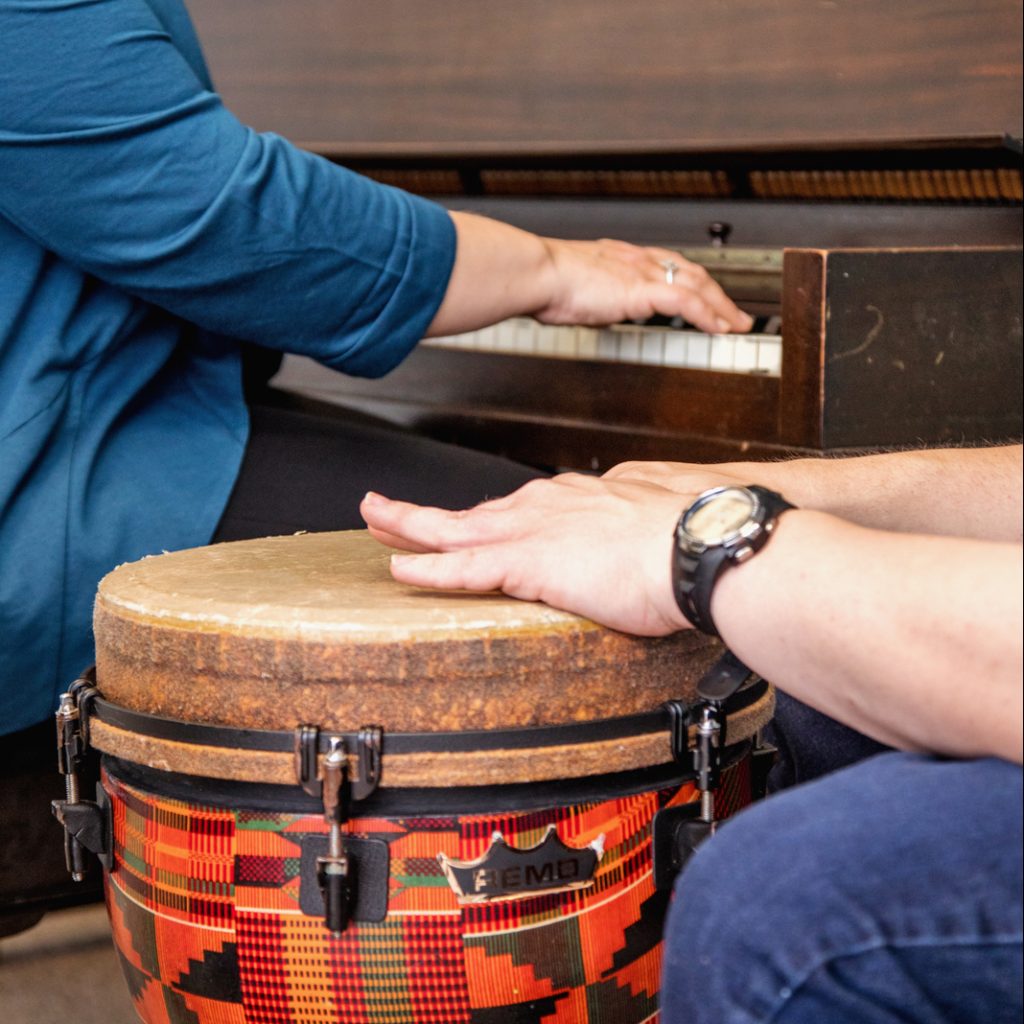Purposeful Music in Music Therapy

What is purposeful music? The official music therapy definition put out by the Canadian Association of Music Therapists states:
“Music therapy is a discipline in which Certified Music Therapists (MTAs) use music purposefully within therapeutic relationships to support development, health, and well-being. Music therapists use music safely and ethically to address human needs within cognitive, communicative, emotional, musical, physical, social, and spiritual domains.”
Canadian Association of Music Therapists, September 2020
Breaking that down, the main points are: certified MTAs using music purposefully, safely and ethically within a therapeutic relationship. (We have our own simplified definition on our Home Page). But what does that really mean? And how is purposeful music different than other musical experiences? Here are some examples of how music therapists use music purposefully every day.
Listening to Music Purposefully
Everyone listens to music. And everyone responds differently to music. To one person, listening to Opera music will soothe their soul, yet it will create agitation in another person. Additionally, individual songs are tied to our memories. Can you remember a song that your mom sang to you as a child? Or how about a song that you danced to with your high school crush?
Music is so personal. Music therapists determine and use songs that are most meaningful to each client. This ensures the music is purposeful. Sometimes this includes listening to recordings but it can also include playing and singing the songs themselves.
Singing with Music Purposefully
Music therapists do a lot of singing with their clients every day. Although this may look like fun (and it really is), every song is selected and or used purposefully. For example, a therapist may choose to sing a song because it has meaningful lyrics, or because the song give the client an opportunity to work on a communication goal.
When using familiar music, the therapist is constantly adjusting the music to make sure the client can sing along successfully. Have you ever tried to sing along with the radio but the song is too high or too low. Well, music therapists are purposeful about playing the song in a key that is well suited to the client.
Additionally, the therapist will also adjust the speed of the song. We will play faster with a client who is singing fast, and slow down to make sure a client who is singing slower can keep up. We will even pause at the end of phrases so a client who can’t sing all the words, has the opportunity to sing the last word of each phrase.
Moving with Music Purposefully
It is difficult to listen to upbeat music without moving your feet or tapping your hand along with the music. Music motivates movement. It is common for music therapists to include some sort of dancing, stretching, or moving during sessions when it supports the client’s treatment plan.
In long-term care, maintaining range of motion is a priority and music therapist will choose songs (and even make up our own) that give the opportunity to do these movements with music that they enjoy. We find that when our clients are listening to music, they often perform movements easier and for longer periods at a time.
With children moving with music serves a very different purpose. Most children need to get their wiggles out between period of focusing. Music therapists will purposefully choose songs that encourage children to move or dance that require very little thinking. This helps calm and refocus the mind before moving on to the next task. And of coarse it is a lot of fun jumping and dancing with music.
Creating Music Purposefully
Improvising with instruments or song writing are techniques used by music therapists to create music with their clients. These provide clients with the opportunity to make their own music with the support of their therapist.
When improvising, clients will play the piano and/or percussive instruments while the therapist plays with them on the piano or another instrument. The therapist is constantly observing and responding to the client’s music. We are purposeful in how we give the client space to express themselves with their instrument. We may initiate some musical play with a back and forth musical conversation to encourage a client to play more. Or we may back off and hold chords giving the client lots of space to express themselves when they want to play a lot.
When writing songs, the music therapist is purposeful in guiding the structure and theme of the song-writing experience. Some clients can create their own lyrics and melody where other clients prefer to add their own ideas to precomposed or even familiar songs. My Favourite Things and If I Had A Million Dollars are two examples of songs that a client can add their ideas to in a simple way.
As you can see there are many ways music therapists use music purposefully. In fact every moment of every music therapy session is purposefully planned and executed. I like to say that all music has the potential to be therapeutic to some extent, but not all music is music therapy. It is the relationship between client and therapist combined with using music purposefully that make music therapy so magical.
By Heidi Flynn, RP, MTA – Registered Psychotherapist & Certified Music Therapist
